表示时间介词用法
- 格式:ppt
- 大小:825.00 KB
- 文档页数:91
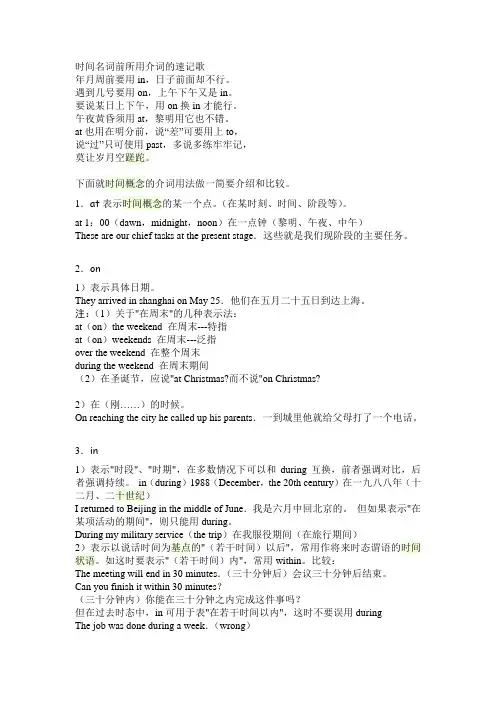
时间名词前所用介词的速记歌年月周前要用in,日子前面却不行。
遇到几号要用on,上午下午又是in。
要说某日上下午,用on换in才能行。
午夜黄昏须用at,黎明用它也不错。
at也用在明分前,说“差”可要用上to,说“过”只可使用past,多说多练牢牢记,莫让岁月空蹉跎。
下面就时间概念的介词用法做一简要介绍和比较。
1.at表示时间概念的某一个点。
(在某时刻、时间、阶段等)。
at 1:00(dawn,midnight,noon)在一点钟(黎明、午夜、中午)These are our chief tasks at the present stage.这些就是我们现阶段的主要任务。
2.on1)表示具体日期。
They arrived in shanghai on May 25.他们在五月二十五日到达上海。
注:(1)关于"在周末"的几种表示法:at(on)the weekend 在周末---特指at(on)weekends 在周末---泛指over the weekend 在整个周末during the weekend 在周末期间(2)在圣诞节,应说"at Christmas?而不说"on Christmas?2)在(刚……)的时候。
On reaching the city he called up his parents.一到城里他就给父母打了一个电话。
3.in1)表示"时段"、"时期",在多数情况下可以和during互换,前者强调对比,后者强调持续。
in(during)1988(December,the 20th century)在一九八八年(十二月、二十世纪)I returned to Beijing in the middle of June.我是六月中回北京的。
但如果表示"在某项活动的期间",则只能用during。
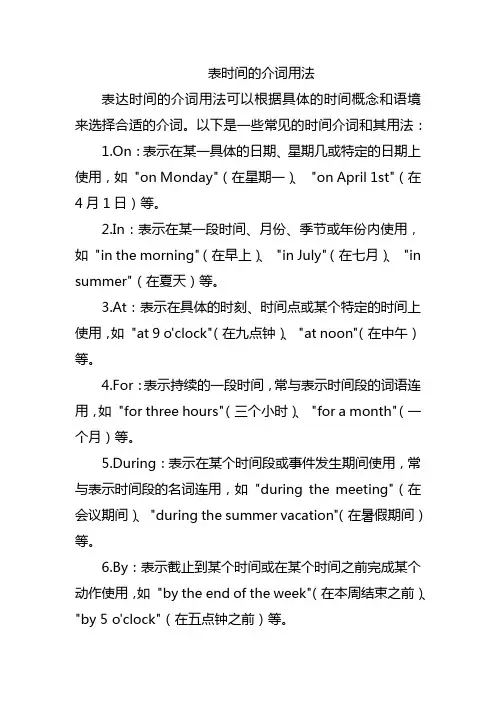
表时间的介词用法
表达时间的介词用法可以根据具体的时间概念和语境来选择合适的介词。
以下是一些常见的时间介词和其用法:
1.On:表示在某一具体的日期、星期几或特定的日期上使用,如"on Monday"(在星期一)、"on April 1st"(在4月1日)等。
2.In:表示在某一段时间、月份、季节或年份内使用,如"in the morning"(在早上)、"in July"(在七月)、"in summer"(在夏天)等。
3.At:表示在具体的时刻、时间点或某个特定的时间上使用,如"at 9 o'clock"(在九点钟)、"at noon"(在中午)等。
4.For:表示持续的一段时间,常与表示时间段的词语连用,如"for three hours"(三个小时)、"for a month"(一个月)等。
5.During:表示在某个时间段或事件发生期间使用,常与表示时间段的名词连用,如"during the meeting"(在会议期间)、"during the summer vacation"(在暑假期间)等。
6.By:表示截止到某个时间或在某个时间之前完成某个动作使用,如"by the end of the week"(在本周结束之前)、"by 5 o'clock"(在五点钟之前)等。
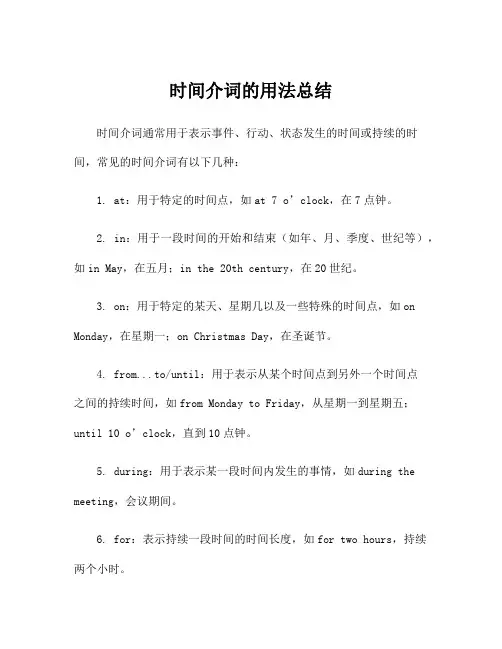
时间介词的用法总结
时间介词通常用于表示事件、行动、状态发生的时间或持续的时间,常见的时间介词有以下几种:
1. at:用于特定的时间点,如at 7 o’clock,在7点钟。
2. in:用于一段时间的开始和结束(如年、月、季度、世纪等),如in May,在五月;in the 20th century,在20世纪。
3. on:用于特定的某天、星期几以及一些特殊的时间点,如on Monday,在星期一;on Christmas Day,在圣诞节。
4. from...to/until:用于表示从某个时间点到另外一个时间点
之间的持续时间,如from Monday to Friday,从星期一到星期五;until 10 o’clock,直到10点钟。
5. during:用于表示某一段时间内发生的事情,如during the meeting,会议期间。
6. for:表示持续一段时间的时间长度,如for two hours,持续两个小时。
需要注意的是,有些时间介词在不同的情况下有着不同的含义,例如at在表示“在某个时间”的同时也可以表示“在某个地点”;in 在表示时间段的同时也可以表示“在某个地点”等等。
另外,虽然时间介词的用法比较固定,但还是要注意具体的语境和句子结构,尽可能准确和恰当地使用时间介词。
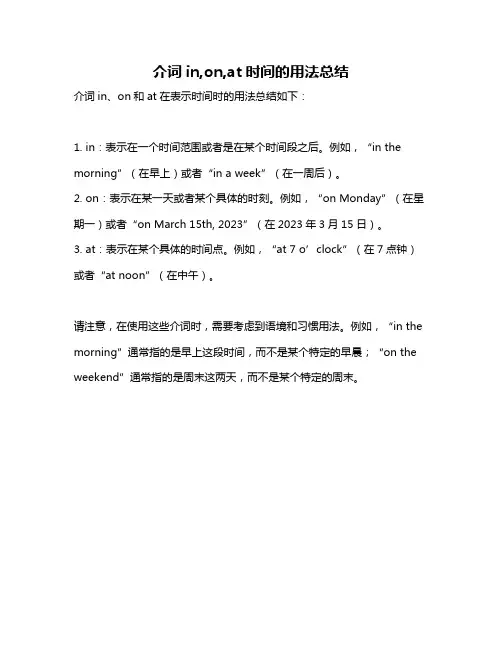
介词in,on,at时间的用法总结
介词in、on和at在表示时间时的用法总结如下:
1. in:表示在一个时间范围或者是在某个时间段之后。
例如,“in the morning”(在早上)或者“in a week”(在一周后)。
2. on:表示在某一天或者某个具体的时刻。
例如,“on Monday”(在星期一)或者“on March 15th, 2023”(在2023年3月15日)。
3. at:表示在某个具体的时间点。
例如,“at 7 o’clock”(在7点钟)或者“at noon”(在中午)。
请注意,在使用这些介词时,需要考虑到语境和习惯用法。
例如,“in the morning”通常指的是早上这段时间,而不是某个特定的早晨;“on the weekend”通常指的是周末这两天,而不是某个特定的周末。
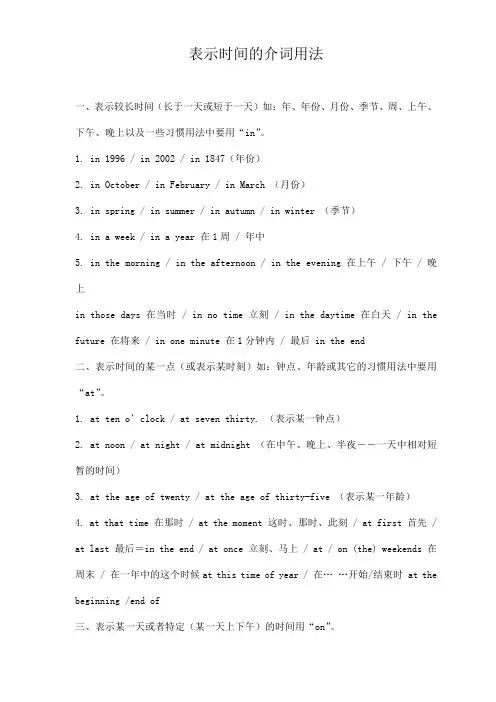
表示时间的介词用法一、表示较长时间(长于一天或短于一天)如:年、年份、月份、季节、周、上午、下午、晚上以及一些习惯用法中要用“in”。
1. in 1996 / in 2002 / in 1847(年份)2. in October / in February / in March (月份)3. in spring / in summer / in autumn / in winter (季节)4. in a week / in a year 在1周 / 年中5. in the morning / in the afternoon / in the evening 在上午 / 下午 / 晚上in those days 在当时 / in no time 立刻 / in the daytime 在白天 / in the future 在将来 / in one minute 在1分钟内 / 最后 in the end二、表示时间的某一点(或表示某时刻)如:钟点、年龄或其它的习惯用法中要用“at”。
1. at ten o’clock / at seven thirty. (表示某一钟点)2. at noon / at night / at midnight (在中午、晚上、半夜――一天中相对短暂的时间)3. at the age of twenty / at the age of thirty-five (表示某一年龄)4. at that time 在那时 / at the moment 这时、那时、此刻 / at first 首先 / at last 最后=in the end / at once 立刻、马上 / at / on (the) weekends 在周末 / 在一年中的这个时候at this time of year / 在……开始/结束时 at the beginning /end of三、表示某一天或者特定(某一天上下午)的时间用“on”。
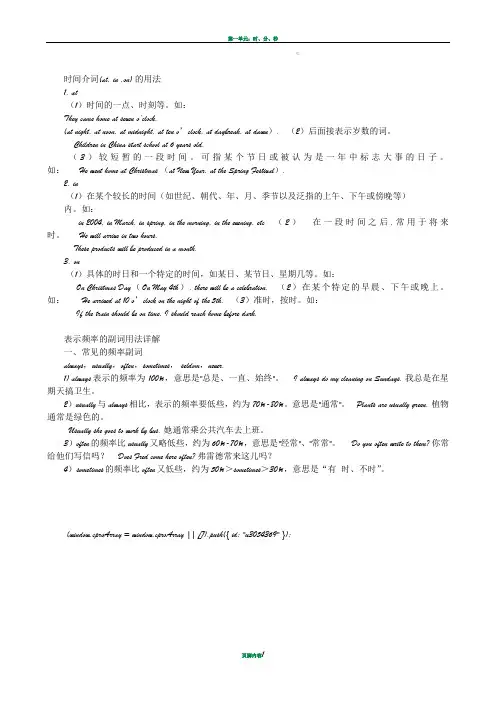
时间介词(at, in ,on) 的用法1. at(1)时间的一点、时刻等。
如:They came home at seven o’clock.(at night, at noon, at midnight, at ten o’clock, at daybreak, at dawn). (2)后面接表示岁数的词。
Children in China start school at 6 years old.(3)较短暂的一段时间。
可指某个节日或被认为是一年中标志大事的日子。
如: He went home at Christmas (at New Year, at the Spring Festival).2. in(1)在某个较长的时间(如世纪、朝代、年、月、季节以及泛指的上午、下午或傍晚等)内。
如:in 2004, in March, in spring, in the morning, in the evening, etc (2)在一段时间之后,常用于将来时。
He will arrive in two hours.These products will be produced in a month.3. on(1)具体的时日和一个特定的时间,如某日、某节日、星期几等。
如:On Christmas Day(On May 4th), there will be a celebration. (2)在某个特定的早晨、下午或晚上。
如: He arrived at 10 o’clock on the night of the 5th. (3)准时,按时。
如:If the train should be on time, I should reach home before dark.表示频率的副词用法详解一、常见的频率副词always,usually,often,sometimes, seldom,never.1) always表示的频率为100%,意思是"总是、一直、始终"。
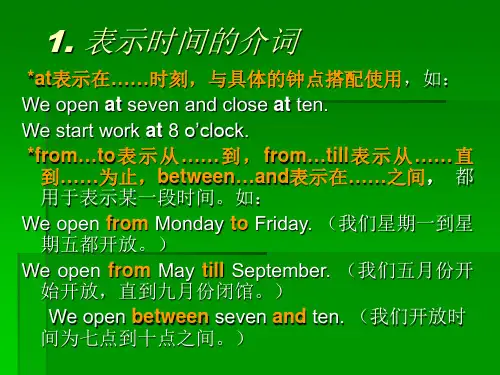
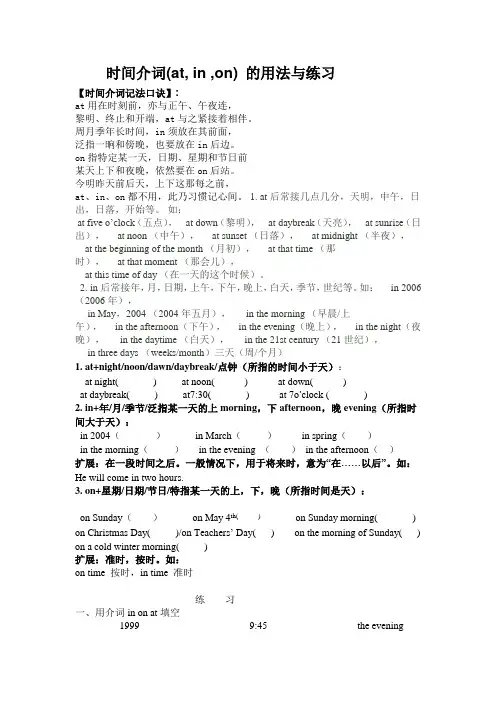
时间介词(at, in ,on) 的用法与练习【时间介词记法口诀】:at用在时刻前,亦与正午、午夜连,黎明、终止和开端,at与之紧接着相伴。
周月季年长时间,in须放在其前面,泛指一晌和傍晚,也要放在in后边。
on指特定某一天,日期、星期和节日前某天上下和夜晚,依然要在on后站。
今明昨天前后天,上下这那每之前,at、in、on都不用,此乃习惯记心间。
1. at后常接几点几分,天明,中午,日出,日落,开始等。
如:at five o’clock(五点), at down (黎明), at daybreak (天亮), at sunrise (日出), at noon (中午), at sunset (日落), at midnight (半夜),at the beginning of the month (月初), at that time (那时), at that moment (那会儿),at this time of day (在一天的这个时候)。
2. in后常接年,月,日期,上午,下午,晚上,白天,季节,世纪等。
如: in 2006(2006年),in May,2004 (2004年五月), in the morning (早晨/上午), in the afternoon (下午), in the evening (晚上), in the night (夜晚), in the daytime (白天), in the 21st century (21世纪),in three days (weeks/month)三天(周/个月)1. at+night/noon/dawn/daybreak/点钟(所指的时间小于天):at night( ) at noon( ) at down( )at daybreak( ) at7:30( ) at 7o’clock ( )2. in+年/月/季节/泛指某一天的上morning,下afternoon,晚evening(所指时间大于天):in 2004()in March()in spring()in the morning()in the evening ()in the afternoon()扩展:在一段时间之后。
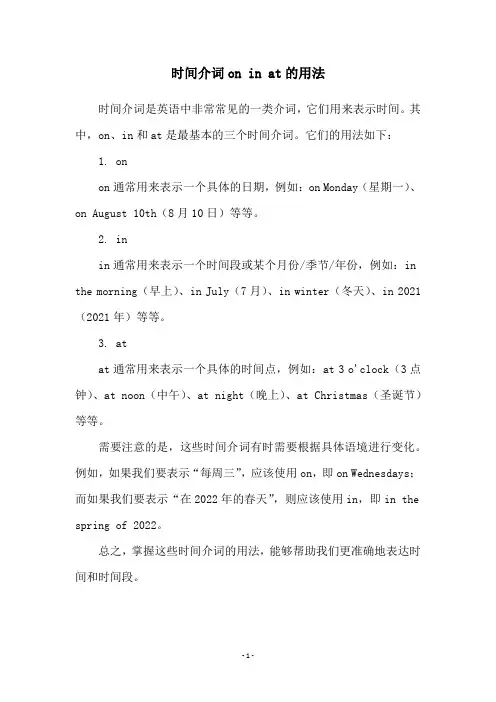
时间介词on in at的用法
时间介词是英语中非常常见的一类介词,它们用来表示时间。
其中,on、in和at是最基本的三个时间介词。
它们的用法如下:
1. on
on通常用来表示一个具体的日期,例如:on Monday(星期一)、on August 10th(8月10日)等等。
2. in
in通常用来表示一个时间段或某个月份/季节/年份,例如:in the morning(早上)、in July(7月)、in winter(冬天)、in 2021(2021年)等等。
3. at
at通常用来表示一个具体的时间点,例如:at 3 o'clock(3点钟)、at noon(中午)、at night(晚上)、at Christmas(圣诞节)等等。
需要注意的是,这些时间介词有时需要根据具体语境进行变化。
例如,如果我们要表示“每周三”,应该使用on,即on Wednesdays;而如果我们要表示“在2022年的春天”,则应该使用in,即in the spring of 2022。
总之,掌握这些时间介词的用法,能够帮助我们更准确地表达时间和时间段。
- 1 -。
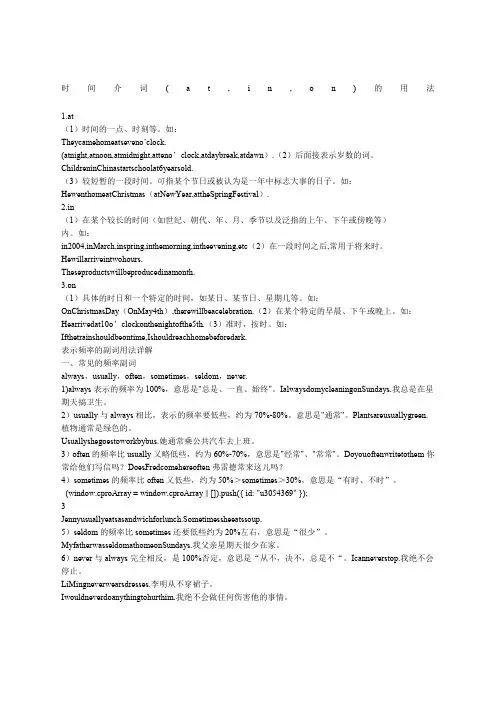
时间介词(a t,i n,o n)的用法1.at(1)时间的一点、时刻等。
如:Theycamehomeatseveno’clock.(atnight,atnoon,atmidnight,atteno’clock,atdaybreak,atdawn).(2)后面接表示岁数的词。
ChildreninChinastartschoolat6yearsold.(3)较短暂的一段时间。
可指某个节日或被认为是一年中标志大事的日子。
如:HewenthomeatChristmas(atNewYear,attheSpringFestival).2.in(1)在某个较长的时间(如世纪、朝代、年、月、季节以及泛指的上午、下午或傍晚等)内。
如:in2004,inMarch,inspring,inthemorning,intheevening,etc(2)在一段时间之后,常用于将来时。
Hewillarriveintwohours.Theseproductswillbeproducedinamonth.3.on(1)具体的时日和一个特定的时间,如某日、某节日、星期几等。
如:OnChristmasDay(OnMay4th),therewillbeacelebration.(2)在某个特定的早晨、下午或晚上。
如:Hearrivedat10o’clockonthenightofthe5th.(3)准时,按时。
如:Ifthetrainshouldbeontime,Ishouldreachhomebeforedark.表示频率的副词用法详解一、常见的频率副词always,usually,often,sometimes,seldom,never.1)always表示的频率为100%,意思是"总是、一直、始终"。
IalwaysdomycleaningonSundays.我总是在星期天搞卫生。
2)usually与always相比,表示的频率要低些,约为70%-80%。
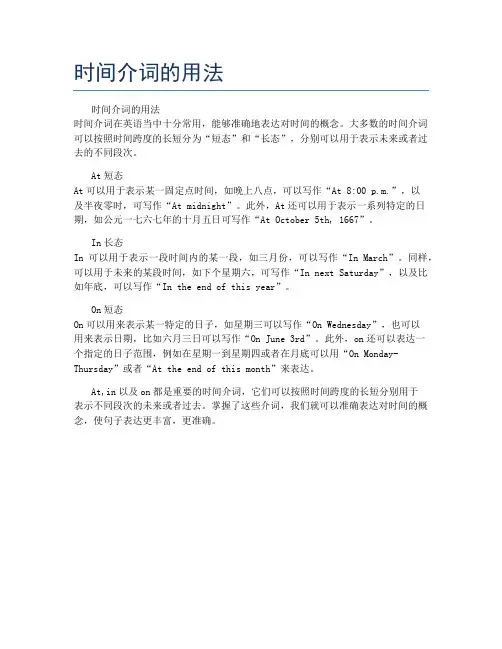
时间介词的用法
时间介词的用法
时间介词在英语当中十分常用,能够准确地表达对时间的概念。
大多数的时间介词可以按照时间跨度的长短分为“短态”和“长态”,分别可以用于表示未来或者过去的不同段次。
At短态
At可以用于表示某一固定点时间,如晚上八点,可以写作“At 8:00 p.m.”,以
及半夜零时,可写作“At midnight”。
此外,At还可以用于表示一系列特定的日期,如公元一七六七年的十月五日可写作“At October 5th, 1667”。
In长态
In可以用于表示一段时间内的某一段,如三月份,可以写作“In March”。
同样,可以用于未来的某段时间,如下个星期六,可写作“In next Saturday”,以及比如年底,可以写作“In the end of this year”。
On短态
On可以用来表示某一特定的日子,如星期三可以写作“On Wednesday”,也可以
用来表示日期,比如六月三日可以写作“On June 3rd”。
此外,on还可以表达一
个指定的日子范围,例如在星期一到星期四或者在月底可以用“On Monday-Thursday”或者“At the end of this month”来表达。
At,in以及on都是重要的时间介词,它们可以按照时间跨度的长短分别用于
表示不同段次的未来或者过去。
掌握了这些介词,我们就可以准确表达对时间的概念,使句子表达更丰富,更准确。
介词的⽤法⼤全介词的⽤法⼀.表⽰时间⽇期的介词1. at:主要表⽰⽅向、场所、时间的某⼀点at the corner of the street,at dinner,at sixty miles an hour,be sold at three yuan a dozen,come at us固定搭配: at one time,at the beginning of,at the post office,at the airport, at the weekend,at the age of 25,at the same time, at present,at any time,表⽰原因,表⽰“见/闻……⽽”。
at the newsat 主要表⽰时间点表⽰特定的时间 at night . 在九点钟表⽰不确定的时间 at night, at that time, at Christmas 在圣诞期间当天 on表⽰年龄段 at the age of eight 在8岁2. in:表⽰场所、时间与期限、状况、⽅向。
主要⽤来表⽰较长的时间单位,如⽉份、季节、年份等in the 1990s in the late 19th century形成“in+时段名词”的词组或固定搭配in those days,in the daytime,in a short while,in no time,in time.in 主要表⽰时间段⼀般指相对较长的时间段⾥ in the morning, in spring, in the past ten years在…时间之后,⽤于将来时 He will be back in a month.介词in在短语或句型中的省略:1) 某些形容词/过去分词后接v-ing形式时,v-ing形式前的介词in可以省略。
be busy (in) doing be engaged (in) doing (忙于……)2) 某些动词如busy等,常与反⾝代词连⽤,其后的in也可以省略。
时间介词的用法总结介词是英语语法中的一类虚词,用来连接名词、代词或动词短语与其他词或短语的词,以表示它们之间的关系。
时间介词就是用来表示时间关系的介词,包括表示具体时间、时间段、频率、顺序等方面的介词。
本文将对时间介词的用法进行总结,包括时间介词的分类、使用方法和注意事项。
一、时间介词的分类根据时间介词表示的时间关系不同,可以将时间介词分为以下几类:1.表示具体时间点的介词:at2.表示时间段的介词:in, on, during, for, since3.表示顺序的介词:before, after, until, by4.表示频率的介词:in, on, at二、时间介词的使用方法1.表示具体时间点的介词at是表示具体时间点的介词,通常用来表示钟点、节日、特定时刻等时间点。
例如:at 7 o'clock, at Christmas, at noon等。
注意:at用于具体的时间点,表示某时某刻的时间点。
2.表示时间段的介词(1)in:通常用来表示较长的时间段,如年、月、季节等。
例如:in 2022, in January, in summer等。
也可用来表示将来的时间。
例如:I will see you in ten minutes.(2)on:通常用来表示某一天或具体日期。
例如:on Monday,on my birthday等。
(3)during:用于表示在整个时间段内进行的动作或事件。
例如:during the meeting, during the holidays等。
(4)for:用来表示持续的时间段。
例如:for two hours, fora week等。
(5)since:用来表示自从某个时间点开始一直持续到现在的时间段。
例如:since 2010, since I was a child等。
注意:since引导的时间段要使用现在完成时态。
3.表示顺序的介词(1)before:表示在某个时间点之前。
介词的种类及用法(三)一,表示时间的介词(for、during、through;by、till/until;)1. for、during、through1). for + 一段时间达……之久(表示经过一段时间);可以和一般现在时、过去时和将来时连用;但经常和完成时连用。
①.He has lived here for six years.他在这儿已经住了六年了。
②.There's enough food for three days.那些食物够你们用3天。
③.It rained continually for three days.雨接连下了三天。
2).during 在……期间;在…的时候①.During the Spring Festival, we make dumplings.在春节里我们包饺子。
②.Neither of us spoke during the journey.旅途中我们谁也没讲话。
3).through 一直…… (从开始到结束)But together, we will make it through the day但我们会一起度过一天2. by、till/until1).by 在……前(时间);到……为止;①.By the end of 在….底/末(之前);They had finished their work by last Sunday.他们在上周日前就完成了任务。
②.by the time + 从句到……的时候By the time he arrived, she had already left.当他到达时,她已经走了。
③. by then 到那时By then we were a safe distance away.到那时,我们已经有了一个安全的距离。
2).till/until 直到……为止;not … until/till 直到…才①.I sometimes stay in bed until lunchtime.有时我要一直躺到吃午饭的时候。
常见介词的用法文/杨学军郭晓伟一、表示时间的介词1)“at+时间点”、“in+时间段”。
表示在“几点几分”等具体时刻要用at;表示在早上、下午、晚上、周、月、季、年、世纪或人生的某个时期等一段期间内要用in。
如:at 3 o’clock 在三点,in the afternoon 在下午。
2)“on+具体的某日或某日的早、午、晚等”。
如:on Monday 在星期一,on May 1st在五一,on the morning of May 2nd在五月二日的早晨。
3)“on+节假日(本身)”,“at+节假日(时节)”。
如:on New Year’s Day 在元旦(那一天),at New Year’s Day 在新年之际,at Christmas 在圣诞节,at Midsummer 在仲夏节,at Easter 在复活节,at the weekend 在周末4)“for+时间段”,“since+过去的时间点”这两种短语都表示“延续的一段时间”,常与完成时态连用,如:For 48 years 48 年(之久),since1994 自从1994年以来5)“in+时间段”,常与将来时动词连用;“after+时间段”,只与过去时瞬间动词连用。
都表示“过多久时间之后将会发生某个动作”。
如:He will come back in two hours.他两小时后就回来。
He came back after two hours.俩个小时后回来了。
二、表示地点、范围、趋向的介词。
1)“at+点”,“on+面”,“in+体”。
如:He stood at the door with a picture on it,looking in through a hole in the door.一个陌生人站在上面贴有一张画的门那儿,正从门上的孔洞里向里观望。
2)“across+表面”,“through+空间”。
如:The river runs through our city,across the firlds and then into the sea.那条河穿过我们城市,流经田野,然后汇入大海。
时间的介词用法
1. 在某个时间点前:before
例如:before noon(中午之前)、before Christmas(圣诞节前)、before 7 o'clock(7点钟前)
2. 在某个时间点后:after
例如:after lunch(午饭后)、after 10 pm(晚上10点后)、after the meeting(会议结束后)
3. 在某个时间段开始:from
例如:from Monday to Friday(从周一到周五)、from 9 am to 5 pm(从早上9点到下午5点)、from the beginning of the movie(电影开始时)
4. 在某个时间段结束:until/till
例如:until next week(下周之前)、till the end of the year(年底之前)、from Monday till Friday(从周一到周五)
5. 在某个时间段内:during
例如:during the summer(夏天期间)、during the class(课堂时间内)、during the concert(音乐会期间)
6. 在某个特定的时间:at
例如:at 8 o'clock(在8点钟)、at noon(在中午)、at midnight(在午夜)
7. 表示时间的范围:between
例如:between 4 and 6 pm(下午4点到6点之间)、between 2010 and 2020(2010年到2020年之间)、between Monday and Wednesday(从周一到周三之间)。